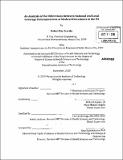An analysis of the differences between national and local coverage determinations of medical procedures in the US
Author(s)
Díaz Treviño, Rafael
DownloadFull printable version (9.579Mb)
Other Contributors
Harvard University--MIT Division of Health Sciences and Technology.
Advisor
Richard Anders and Teo Forcht Dagi.
Terms of use
Metadata
Show full item recordAbstract
Medicare coverage policies of medical procedures can be promulgated at a national level by the Centers of Medicare and Medicaid Services (CMS) as National Coverage Determinations (NCDs) or at a local level by Medicare contractors as Local Coverage Determinations (LCDs). Although LCDs shouldn't contradict NCDs, they can differ. In the present study, I analyze some factors that could partially account for the differences between NCDs and LCDs. Using the Medicare Coverage Database from CMS, I searched for differences between NCDs and LCDs in five benefit categories: inpatient hospital services, durable medical devices, diagnostic laboratory tests, physician's services and other diagnostic tests. There is a reasonable degree of homogeneity in coverage policies for procedures for which an NCD has been issued: 82% are exactly the same. Most of the differences took the form of exclusions from LCDs, but not from NCDs. For each state, I computed the number of times that LCDs were issued and the number of times that LCDs differed from NCDs and searched for possible linear or exponential correlation models. The following factors were initially hypothesized to account for these differences: number of Schools of Medicine, number of physicians, GDP per capita by state, state ranking according to number of Level 1 and Level 2 Trauma Centers and the profile of MEDCAC members. At a national level, I found no correlation between the number of LCDs issued or the number of differences between LCDs and NCDs and any of these variables. However, on a sub-analysis at a local level, in some regions I found a positive correlation (r2 >.94) between the following three variables: 1) number of Schools of Medicine, 2) number of physicians, and 3) state ranking according to the number of Level 1 and Level 2 Trauma Centers and the following two parameters: 1) the level of LCD issuing activity, and 2) the number of times that LCDs differ from NCDs. The correlations shown by the performed sub-analysis within regions may imply that more LCDs are issued to restrict coverage when there is a local need to control the excessive demand partially driven by the higher number of hospitals and physicians that are active in pursuing their interests. The fact that these correlations were shown only at a regional level may indicate that when local factors are disregarded, the original hypothesized factors do influence LCD activity, however, at a national level, other hypothetical local factors may have a greater influence on LCD activity and policy discrepancies. In order to have a better understanding of my results and the factors that could account for the differences between NCDs and LCDs, I interviewed four Contractor Medical Directors (CMDs). These interviews indicated that other factors could account for these differences, including the following: a history of abuse and fraud, contractor's budgets, the CMD's special interests and experience, data analysis capabilities, the number of claims and the novelty of the procedure. The impact of these variables on the differences between national and local coverage policies can be an interesting topic for future research on the subject.
Description
Thesis (S.M.)--Harvard-MIT Division of Health Sciences and Technology, 2010. Cataloged from PDF version of thesis. Includes bibliographical references (p. 87).
Date issued
2010Department
Harvard University--MIT Division of Health Sciences and TechnologyPublisher
Massachusetts Institute of Technology
Keywords
Harvard University--MIT Division of Health Sciences and Technology.